Frequently Asked Questions About Indian Point Effluent Releases
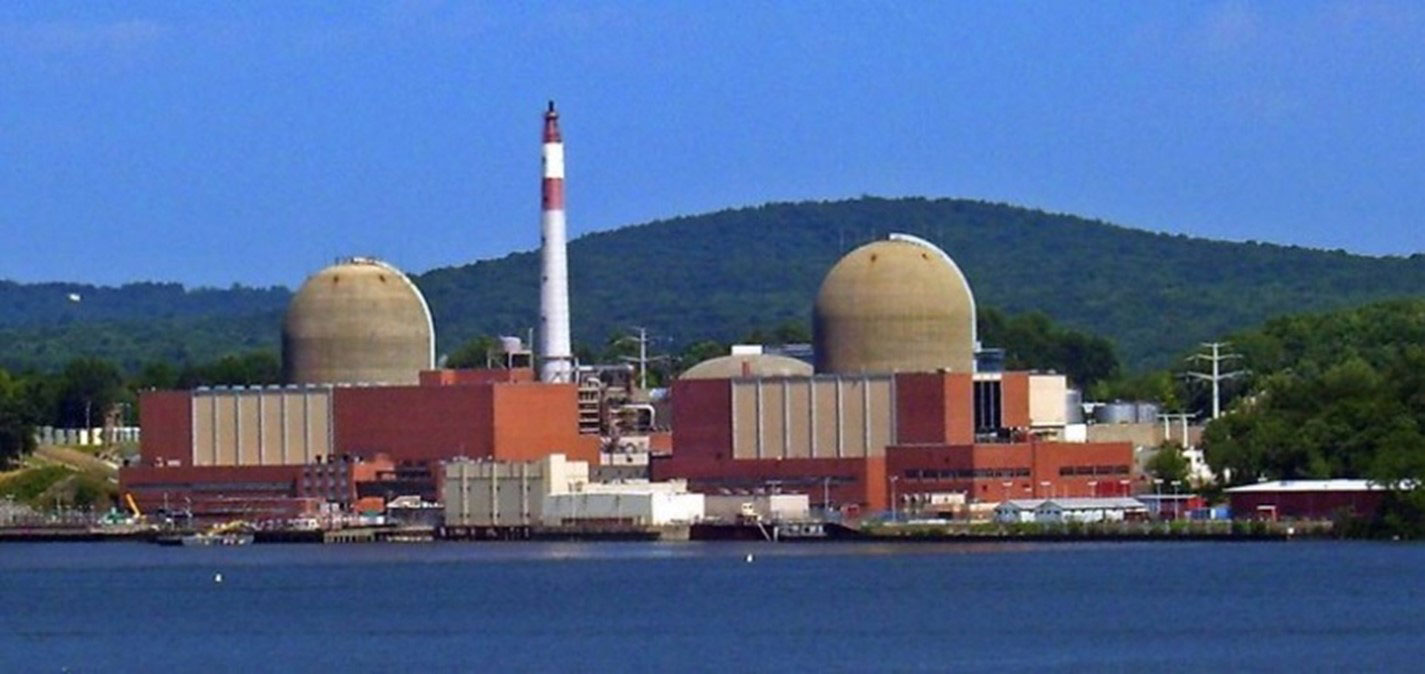
Release and Monitoring
- Where does effluent release happen at Indian Point?
- How are effluent releases monitored?
- How long has effluent release been happening at Indian Point?
- When Indian Point releases effluents, is Holtec required to notify the NRC?
- What is the Holtec Radioactive Effluent Controls Program?
- Who is responsible for determining how effluents are released from Indian Point?
- Who is monitoring the impact of the radioactive effluent releases on the Hudson River?
- Does NRC require independent analysis of how frequently Holtec’s tests of effluents are checked by an independent authority?
Public and Environmental Impacts
- How do radioactive effluent releases impact the public?
- Has Indian Point exceeded any regulatory limit relative to radiological releases to the environment?
- Is there a way to analyze the cumulative impact that Indian Point effluent releases have had on the Hudson River?
- Does the NRC plan on conducting additional evaluations of the environmental and public health impacts of releasing radioactive water from Indian Point into the Hudson River?
- When was the last time the NRC’s current dose limits for workers or members of the public were reviewed or changed?
- How often does the NRC evaluate potential changes that may be warranted for such dose limits?
- How is the dose to the public calculated for effluent from Indian Point? How was that calculation developed?
Regulations
- What are the NRC’s regulations for radioactive releases?
- How does the NRC work with the U.S. Environmental Protection Agency (EPA) to regulate Holtec’s proposed effluent releases?
- Does Holtec need NRC permission, or to notify any other federal or state agency, prior to an effluent release?
- How is effluent release regulated and verified to be within the regulatory limits at Indian Point?
- Besides formal annual reports, how often does the NRC monitor or verify Holtec’s data regarding effluent releases and groundwater monitoring?
- Why are effluent release reports submitted annually to the NRC?
Additional Information
- What steps has the NRC taken to improve public education and transparency concerns regarding future releases of radioactive water from Indian Point?
- Where can I obtain more information on effluent releases?
Where does effluent release happen at Indian Point?
Effluent releases happen at discrete discharge points at the Indian Point facility, such as the discharge piping for liquid releases and through filtered release points for gaseous releases.
How are effluent releases monitored?
NRC-licensed facilities may discharge monitored and treated radiological wastes (i.e., gases, liquids, or particulates) into the environment provided that dose limits to members of the public (see 10 CFR 20.1301) are not exceeded and that doses are maintained as low as reasonably achievable (ALARA).
Effluent radiation monitors are used at facilities, such as nuclear power plants undergoing decommissioning, to monitor releases from discrete discharge points, such as the plant stack for airborne releases or a discharge conduit for liquid releases. The licensee samples the releases and measures the radiation in the samples at the release points, where the concentration is the highest.
In addition, the NRC provides oversight, through its inspection program, of the licensee’s compliance with the NRC regulations related to effluent release, monitoring, and reporting, to ensure public health and safety associated with operation of the facility.
As part of the oversight process, the NRC also requires annual reports from the licensee that record and analyze the release of effluents or removal of waste products from the facility via shipment of radioactive waste to licensed waste repositories. Those annual reports can be found on the Radioactive Effluent and Environmental Reports for Indian Point, Units 2 and 3 page, and the latest report for calendar year 2022 can be located at ML23118A070.
How long has effluent release been happening at Indian Point?
The controlled release of effluents within specified limits has been an established part of normal nuclear facility operations and decommissioning, including at Indian Point, where liquid and gaseous effluents have been discharged as a normal part of operation for over 60 years. The NRC’s regulations and licensing reviews for the facility take into account such releases as part of the NRC’s safety and environmental determinations.
The number and volume of batch liquid releases at Indian Point, as well as the dose results from those releases over the past several years, are captured in the graph below.
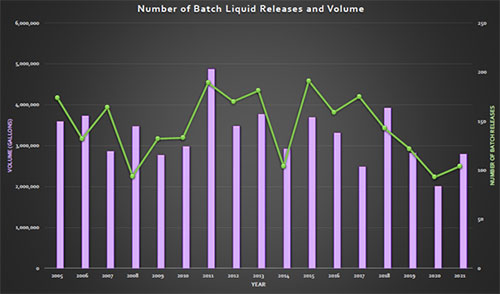
When Indian Point releases effluents, is Holtec required to notify the NRC?
Holtec must notify the NRC if any of the NRC’s regulatory limits for effluents, or certain limits established in the Indian Point Off-Site Dose Calculation Manual (ODCM) related to ALARA goals, would be exceeded. In such an instance, Holtec would be required to prepare and submit a report to the NRC, as described in the ODCM. The report would include, in part, identification of the cause(s) of exceeding certain limit(s) and a description of corrective actions planned and taken. Should such a report be received, the NRC staff would conduct inspections and determine any necessary enforcement actions.
The NRC’s regulations and conditions in the license issued to Holtec for Indian Point require Holtec to ensure that the releases of gaseous and liquid effluents meet the applicable NRC and U.S. Environmental Protection Agency (EPA) requirements. The NRC also requires Holtec to maintain a radiological environmental monitoring program (REMP) for Indian Point to provide data on measurable levels of radiation and radioactive materials in the local environment.
In addition, Holtec is required to submit to the NRC an annual radiological environmental operating report with the results of the REMP and a radioactive effluent release report every year, both of which are publicly available on the Radioactive Effluent and Environmental Reports for Indian Point 2 & 3 page. As part of its oversight activities, the NRC staff reviews Holtec’s ongoing compliance with regulations and license conditions, as well as compliance with recordkeeping and notification requirements. With this regulatory framework in place, separate NRC approval for each effluent release is not required.
What is the Holtec Radioactive Effluent Controls Program?
To ensure that Holtec is meeting the technical specifications in its license relating to radioactive effluents, the NRC reviewed and approved Indian Point’s ODCM, which Holtec uses to comply with its technical specifications. Specifically, the Radioactive Effluent Controls Program in the Indian Point technical specifications establishes requirements that:
- ensure capability of radioactivity monitoring instrumentation;
- limit concentrations of released radioactive materials;
- require monitoring, sampling, and analysis of effluents;
- limit public dose to meet ALARA criteria;
- track the amount of dose to the public at least every 31 days;
- require the use of effluent treatment systems; and
- limit the release rate of gaseous effluents (liquid effluent releases are limited by item b. above).
The requirements outlined in the Indian Point Radioactive Effluent Controls Program are designed to ensure that the release of any effluents is protective of public health and safety and the environment.
Who is responsible for determining how effluents are released from Indian Point?
Holtec is responsible for the decommissioning of Indian Point and determines how it will manage radioactive effluents and wastes produced as a result of the decommissioning process. Holtec may elect to use any of the methods for disposal allowed under the NRC's regulations, which include discharge, shipment for disposal, or evaporation of the liquid and disposal of the resulting solid waste.
Holtec is required to keep records of releases, along with documentation that demonstrates that it is meeting the license conditions and applicable regulations for the releases. The NRC will review the Indian Point ODCM, which Holtec must use to comply with its license and technical specifications. The NRC also routinely inspects Holtec for compliance with the NRC regulations, their license, and approved manuals and procedures related to effluent releases.
Who is monitoring the impact of the radioactive effluent releases on the Hudson River?
Holtec is required to conduct routine environmental sampling, including of vegetation, Hudson River water, Hudson River Bottom sediment, fish, and invertebrates, through its REMP. Holtec is required to continue to provide the REMP results to the NRC in the licensee’s annual radiological environmental operating report, which is publicly available. Holtec conducts all environmental sampling for Indian Point, and the NRC inspects and reviews the sample collection methodology, measurements, and analyses of effluent samples to ensure that releases of radioactive materials are adequately quantified and evaluated and meet NRC requirements. In addition, Holtec splits many of the environmental samples with the State of New York, who conducts additional testing on the samples for independent results.
Does NRC require independent analysis of how frequently Holtec’s tests of effluents are checked by an independent authority?
No, the NRC does not require another entity to do an independent analysis. The NRC staff performs its own independent evaluations of the licensee’s radiation surveys during inspection activities. The NRC also performs an annual programmatic review that focuses specifically on radioactive waste treatment, as well as effluent and environmental monitoring.
The NRC staff maintains oversight of Holtec’s compliance with the NRC regulations related to effluent release, monitoring, and reporting to provide reasonable assurance of adequate protection of public health and safety associated with the decommissioning of the facility.
How do radioactive effluent releases impact the public?
The NRC provides reasonable assurance of adequate protection of public health and safety by establishing regulatory dose limits for radioactive releases consistent with ALARA principles and by requiring licensees to conduct environmental monitoring programs. When the NRC promulgated the regulations related to dose limits to the public, the NRC took many factors into consideration, including the impacts to members of the public and the environment at any given time. The graphics below provide additional information regarding the sources of radiation exposure in the environment, and how those doses compare.
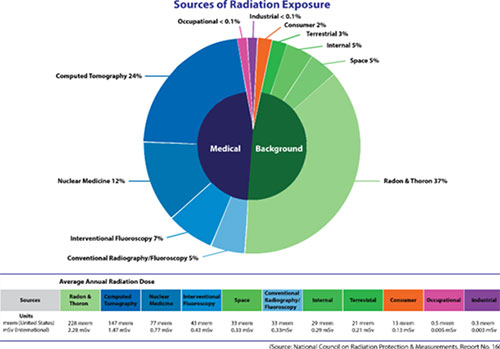
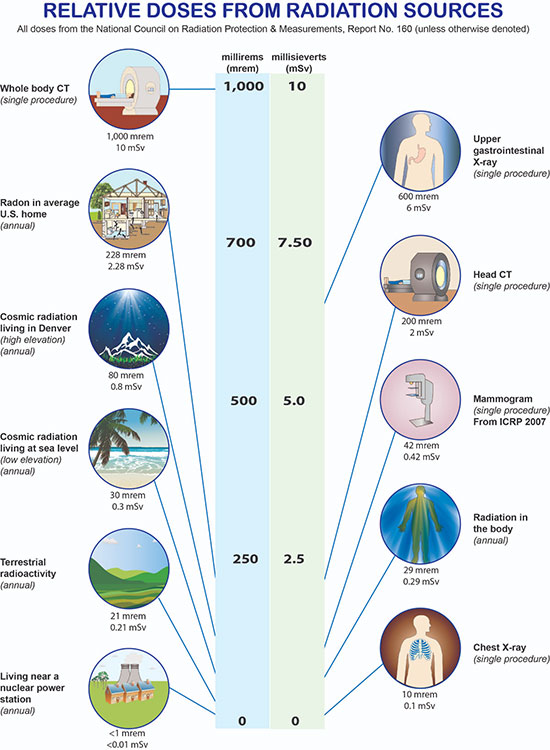
Has Indian Point exceeded any regulatory limit relative to radiological releases to the environment?
No; to date, Indian Point has not exceeded any regulatory limit related to radiological releases to the environment. Indian Point is required by the plant technical specifications to have a Radioactive Effluent Controls Program, whose objective is to keep doses to members of the public within regulatory limits and ALARA.
The goal for liquid effluents is to keep annual dose less than 3 millirem to the total body and less than 10 millirem to any organ. If these limits are exceeded, the licensee must report the exceedance to the NRC and take corrective action. The annual legal limits, which could result in a civil penalty, include a limit of 100 millirem as stated in 10 CFR 20.1301 and 25 millirem whole body or 75 millirem to the thyroid as stated in 40 CFR 190.10.
To date, all batch liquid effluent releases at Indian Point have been a small fraction of the allowable limits for such releases, as shown in the chart below through the blue figures.
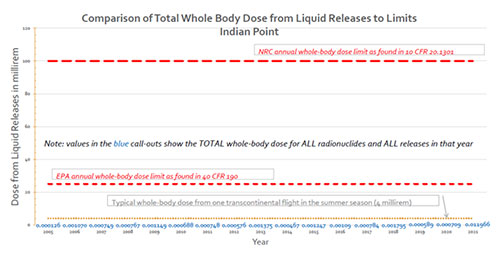
Is there a way to analyze the cumulative impact that Indian Point effluent releases have had on the Hudson River?
The REMP sampling program helps to track and analyze the cumulative impact, if any, that Indian Point radioactive effluent releases have had on the Hudson River. The results are reported in the annual radiological environmental operating report. The NRC considered the cumulative impacts of these releases as part of the environmental reviews conducted during the licensing process for initial operation of the facility, as well as during the evaluation for license renewal of Indian Point. In addition, the NRC will conduct an additional environmental review during decommissioning when the licensee submits the License Termination Plan.
Does the NRC plan on conducting additional evaluations of the environmental and public health impacts of releasing radioactive water from Indian Point into the Hudson River?
At this time the NRC does not plan to conduct additional evaluations; however, the NRC will evaluate the effluent release information as it pertains to the environmental impacts of decommissioning Indian Point when the licensee submits the License Termination Plan.
Evaluations regarding the release of effluents from Indian Point were conducted during the initial licensing phase and renewal licensing reviews for Indian Point. As indicated in the Indian Point Post Shutdown Decommissioning Activities Report, the planned decommissioning activities, including the release of effluents, are bounded by the prior environmental analyses for the site.
The NRC staff maintains oversight of Holtec’s compliance with the NRC regulations related to effluent release, monitoring, and reporting to provide reasonable assurance of adequate protection of public health and safety associated with the decommissioning of the facility.
When was the last time the NRC’s current dose limits for workers or members of the public were reviewed or changed?
The most recent update to the NRC’s radiation protection dose limits was the May 21, 1991, revision of 10 CFR Part 20. However, the NRC staff continually maintains awareness of both International Commission on Radiological Protection (ICRP) recommendations and National Council on Radiation Protection and Measurements (NCRP) reports to inform both ongoing actions and future updates to the NRC’s requirements for dose limits to workers and members of the public.
The NRC formally reviewed its regulations and initiated rulemaking in 2012 to revise radiation protection regulations and guidance to achieve a closer alignment with the dose terminology and methodology of more recent ICRP recommendations, among other changes. However, in December 2016, this rulemaking effort was discontinued (81 FR 95410) based on the conclusion that the current NRC regulatory framework continues to provide adequate protection of the health and safety of workers, the public, and the environment.
Additionally, in 2021 the NRC reviewed three petitions for rulemaking requesting that the NRC amend its radiation protection regulations in 10 CFR Part 20 based on what the petitioners asserted was new science and evidence that contradicts the linear no-threshold (LNT) dose-effect model that serves as the basis for the NRC's radiation protection regulations. The NRC evaluated these requests against the current radiation protection requirements and determined that the LNT model continues to provide a sound regulatory basis for minimizing the risk of unnecessary radiation exposure to both members of the public and radiation workers. Therefore the three petitions for rulemaking were denied; for more information see 86 FR 45923.
How often does the NRC evaluate potential changes that may be warranted for such dose limits?
The NRC staff continually reviews and maintains awareness of NCRP and ICRP recommendations, as well as changes to or discussions of dose limits taking place within other regulatory organizations. Many of these interactions are held as public meetings to discuss potential changes and decide with stakeholder involvement how to update or incorporate any new recommendations.
How is the dose to the public calculated for effluent from Indian Point? How was that calculation developed?
The NRC's guidance provides methods to determine dose. For example, Regulatory Guide (RG) 1.21, "Measuring, Evaluating, and Reporting Radioactive Material in Liquid and Gaseous Effluents and Solid Waste," provides extensive details on calculational models. The models were developed in coordination with US National Laboratories (e.g., Pacific Northwest National Laboratory and Oak Ridge National Laboratory). Licensees use RG 1.21 and other guidance to develop the site-specific Offsite Dose Calculation Manual (ODCM) that requires NRC approval.
RG 1.21 identifies liquid and gaseous effluent pathways as primary radiation exposure pathways. The liquid effluent pathways are drinking water, aquatic foods, shoreline deposits and irrigated foods. The gaseous pathways are exposure to airborne radioactive materials as well as potential deposition onto food crops. Equations and references for performing the liquid effluent pathway calculations are provided in Appendix A. Equations for calculating doses from noble gases are provided in Appendix B. Equations for other radionuclides are provided in Appendix C of RG 1.109.
What are the NRC’s regulations for radioactive releases?
Information on the NRC's Regulations for Radioactive Release:
The NRC’s regulations governing radioactive releases are based on dose to the public, not the volume of the release (see 10 CFR 20.2001; 20.1301; 20.2003; 20.2004; 20.2005; and 10 CFR 35.92). The same requirements apply to decommissioning and operating reactors. During decommissioning, the NRC continues to inspect the licensee’s effluent and environmental programs at least annually.
Key Technical NRC Regulatory Guides (RG) on Radiological Effluents:
- RG 1.109, Calculation of Annual Doses to Man from Routine Releases of Reactor Effluents for the Purpose of Evaluating Compliance with 10 CFR Part 50, Appendix I, provides the detailed implementation guidance for demonstrating that radioactive effluents conform to the ALARA design objectives of 10 CFR Part 50, Appendix I.
- RG 1.21, Measuring, Evaluating, and Reporting Radioactive Materials in Liquid and Gaseous Effluents and Solid Waste, addresses the measuring, evaluating, and reporting of effluent releases, solid radioactive waste shipments, and public dose from nuclear power plants.
- RG 4.1, Radiological Environmental Monitoring for Nuclear Power Plants, discusses principles and concepts important to environmental monitoring at nuclear power plants. The RG provides guidance on radiological environmental monitoring programs for routinely monitored exposure pathways and annual reporting to the NRC.
How does the NRC work with the EPA to regulate Holtec’s proposed effluent releases?
The NRC has regulatory requirements governing the discharge of radioactive gaseous and liquid effluents from nuclear facilities. The EPA issues National Pollutant Discharge Elimination System permits that establish requirements for the discharge of non-radiological constituents of wastewater. In some states, such as New York, the EPA delegates the regulation of non‑radiological effluents to state agencies; New York implements non-radiological effluent limits for Indian Points through a State Pollutant Discharge Elimination System permit.
The NRC provides oversight of the controlled release of effluents containing radioactive materials through its regulations, site-specific licensing reviews, and inspections of nuclear power plants, including Indian Point. The NRC implements EPA’s standards through incorporation of the EPA regulations found in 40 CFR Part 190, “Environmental Radiation Protection Standards for Nuclear Power Operations,” into the NRC’s regulations in 10 CFR Part 20. As government agencies, the NRC and EPA continue to communicate as appropriate to regulate effluent releases within their respective purview.
Does Holtec need NRC permission, or to notify any other federal or state agency, prior to an effluent release?
Decommissioning licensees, including Holtec, are not required to notify the NRC of liquid effluent releases provided that the effluents being released are within the limits of their license. If Holtec wanted to release effluents not approved by its license, it would need to request and receive approval from the NRC prior to the release. Notifications to other state or federal agencies are conducted in accordance with the specific permits or other requirements in place with those entities. The NRC doesn’t track the licensee’s notification of effluent releases to other federal or state agencies.
How is effluent release regulated and verified to be within the regulatory limits at Indian Point?
The radiological releases at Indian Point are required to be within established regulatory limits. The determination of the dose from an effluent release is evaluated using specific requirements and controls that are a part of the site’s NRC-approved licensing basis. As required by its license, every licensee, including Holtec, must obtain representative effluent samples, conduct analysis, and then perform a dose calculation to estimate the dose from any planned release to ensure that it will meet regulatory requirements. Although NRC notification is not required prior to any release, all licensees must keep records of this information and make it available for NRC review and routine inspection, as well as including it in the annual, publicly available Radioactive Effluent and Environmental Report.
Besides formal annual reports, how often does the NRC monitor or verify Holtec’s data regarding effluent releases and groundwater monitoring?
The NRC staff evaluates the licensee’s actions in this area during inspection activities under multiple inspection procedures throughout the year and performs a programmatic review annually that focuses specifically on radioactive waste treatment, as well as effluent and environmental monitoring. The NRC staff uses a risk-informed, performance-based approach to plan and conduct these inspections.
Why are effluent release reports submitted annually to the NRC?
The NRC regulations, specifically 10 CFR 50.36a, “Technical specifications on effluents from nuclear power reactors,” require each license of a nuclear power reactor to include technical specifications that require submission of effluent release reports annually. The NRC uses this information as part of its inspection program to verify licensee compliance.
In its promulgation of the regulations in 10 CFR 50.36a, the NRC determined that annual reporting of this information was appropriate. There is no current discussion of changing the public reporting requirements related to effluent releases and environmental monitoring as the NRC has previously determined that the annual reporting frequency is protective of public health and safety and the environment and adequate to allow the NRC to provide oversight in this area.
What steps has the NRC taken to improve public education and transparency concerns regarding future releases of radioactive water from Indian Point?
The NRC values transparency and continues to take actions to enhance transparency related to issues of interest to the community. The NRC also engages with the Indian Point Decommissioning Oversight Board to help educate the public and answer questions related to effluent releases. Also, the NRC hosted a public meeting on November 30, 2022, regarding the decommissioning of Indian Point, where the NRC staff provided information and answered questions on a variety of topics related to NRC oversight of spent fuel cask movement and storage, associated security and emergency preparedness requirements, aging management considerations, and the regional inspection program. The video recording is available on the public meetings page.
Where can I obtain more information on effluent releases?
Page Last Reviewed/Updated Thursday, October 02, 2025
Page Last Reviewed/Updated Thursday, October 02, 2025

